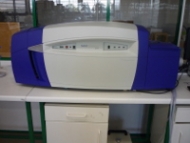Circular Dichroism
Circular Dichroism (CD) is an absorption spectroscopy method based on the differential absorption of left and right circularly polarized light. CD spectroscopy can provide information on the structure of proteins, peptides, nucleic acids and other chiral compounds having a wide range of applications in many different fields.
Application examples:
Proteins
- Secondary structure prediction
- Tertiary structure fingerprint
- Detection of conformational changes
- Structural analysis of recombinant native proteins and its mutants
- Effect of experimental conditions on protein conformation
- Measurement of protein stability
- Follow-up of protein folding
- Study of binding interactions
Nucleic Acids
- Determination of nucleic acids conformations
- A,B and Z forms
- Guanine quadruplexes
- Cytosine quadruplexes
- DNA fragments rich in guanine and adenine
The available equipment at BioLAb is the Applied Photophysics Chirascan™ qCD spectrometer, a modern and powerful device that allows fast and sensitive analysis. We also operate with SX20 Stopped Flow accessory that allows CD and absorbance stopped-flow measurements of high sensitivity. The Pro-KIV Kinetic Global Analysis and the Global 3 Thermal Analysis software enable the analysis of multi-wavelength kinetics and temperature ramps respectively.

Latest publications with our Chriascan qCD:
|
Bragança, P. M. S. et al. Incorporation of a molybdenum atom in a Rubredoxin-type Centre of a de novo-designed α3DIV-L21C three-helical bundle peptide. J. Inorg. Biochem. 240, (2023). |
|
|
Meneses, L. et al. Improving the activity of horseradish peroxidase in betaine-based natural deep eutectic systems. RSC Sustain. 1, 886-897 (2023). |
|
|
Oliveira, R. N. S., de Aguiar, S. R. M. M. & Pauleta, S. R. Coordination of the N-Terminal Heme in the Non-Classical Peroxidase from Escherichia coli. Molecules 28, (2023). |
|
|
Lychko, I., Soares, C. L., Dias, A. M. G. C. & Roque, A. C. A. A scalable method to purify reflectins from inclusion bodies. Sep. Purif. Technol. 315, (2023). |
|
Circular Dichroism
Circular Dichroism (CD) is an absorption spectroscopy method based on the differential absorption of left and right circularly polarized light. CD spectroscopy can provide information on the structure of proteins, peptides, nucleic acids and other chiral compounds having a wide range of applications in many different fields.
Application examples:
Proteins
- Secondary structure prediction
- Tertiary structure fingerprint
- Detection of conformational changes
- Structural analysis of recombinant native proteins and its mutants
- Effect of experimental conditions on protein conformation
- Measurement of protein stability
- Follow-up of protein folding
- Study of binding interactions
Nucleic Acids
- Determination of nucleic acids conformations
- A,B and Z forms
- Guanine quadruplexes
- Cytosine quadruplexes
- DNA fragments rich in guanine and adenine
The available equipment at BioLAb is the Applied Photophysics Chirascan™ qCD spectrometer, a modern and powerful device that allows fast and sensitive analysis. We also operate with SX20 Stopped Flow accessory that allows CD and absorbance stopped-flow measurements of high sensitivity. The Pro-KIV Kinetic Global Analysis and the Global 3 Thermal Analysis software enable the analysis of multi-wavelength kinetics and temperature ramps respectively.

Latest publications with our Chriascan qCD:
|
Bragança, P. M. S. et al. Incorporation of a molybdenum atom in a Rubredoxin-type Centre of a de novo-designed α3DIV-L21C three-helical bundle peptide. J. Inorg. Biochem. 240, (2023). |
|
|
Meneses, L. et al. Improving the activity of horseradish peroxidase in betaine-based natural deep eutectic systems. RSC Sustain. 1, 886-897 (2023). |
|
|
Oliveira, R. N. S., de Aguiar, S. R. M. M. & Pauleta, S. R. Coordination of the N-Terminal Heme in the Non-Classical Peroxidase from Escherichia coli. Molecules 28, (2023). |
|
|
Lychko, I., Soares, C. L., Dias, A. M. G. C. & Roque, A. C. A. A scalable method to purify reflectins from inclusion bodies. Sep. Purif. Technol. 315, (2023). |
|
